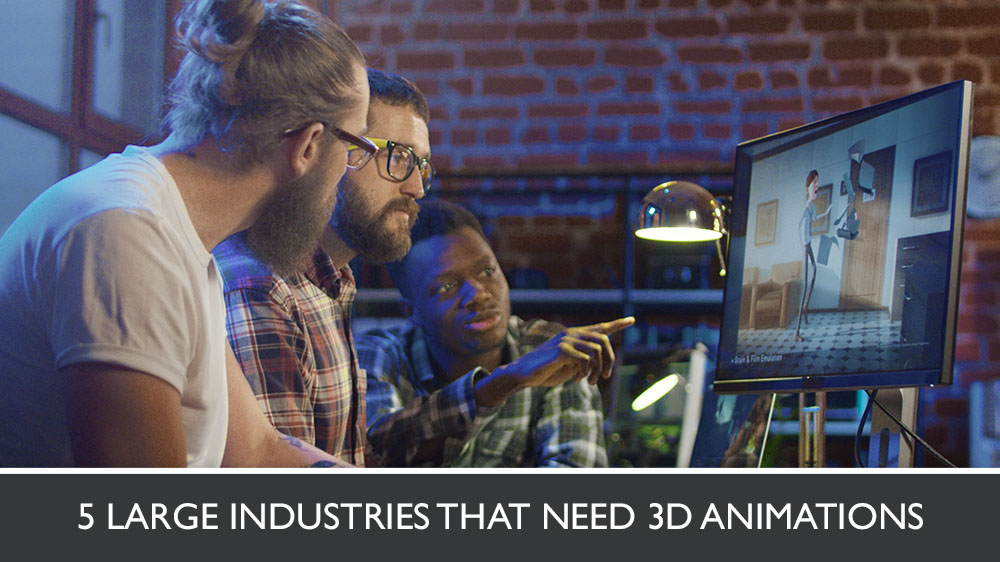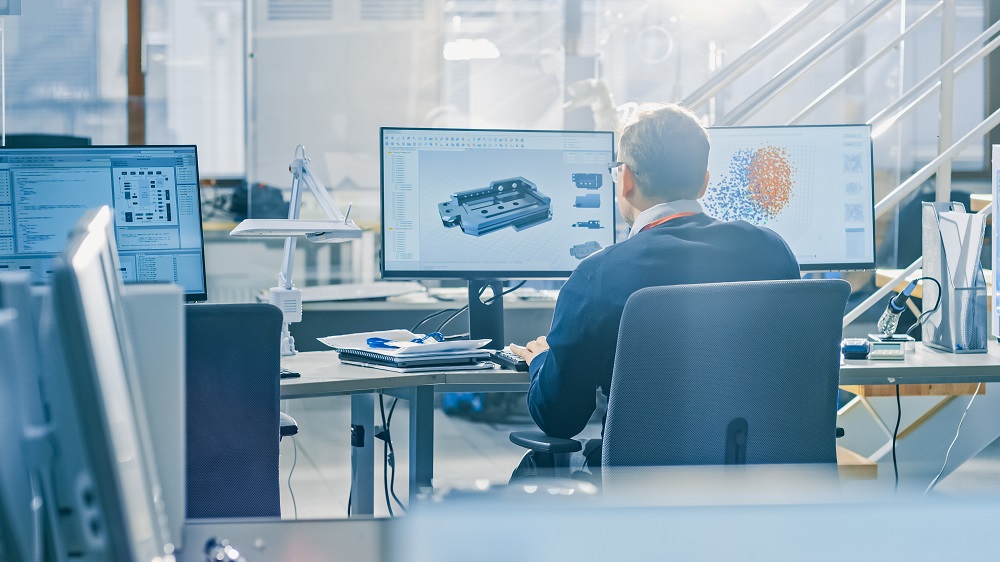Since its advent about 60 years ago, 3D animation design has changed a lot of industries forever. Despite being usually associated with cinematography, the technology has been put to good use in lots of other fields.
So, how and when did it all start? In 1960, workers of the Royal Institute of Technology in Sweden created a 49-second vector animation of an auto driving down a highway. This was the first digital movie ever made. Then, in 1964, the technology was further developed by William Fetter. He was a graphic designer at the Boeing aircraft manufacturing company. Fetter started to experiment with 3D models of people. As a result, he created the first human-looking 3D characters of pilots and animated them. These were the first animated wireframe models ever made. Fetter used them in videos that helped check ergonomic characteristics of aircraft cockpits.
Later on, 3D graphics stormed into the filmmaking industry. In 1967, the US artist Charles Csuri created a ten-minute animated film called ‘Hummingbird’. But it wasn’t until 1995 that 3D animation design managed to grab the whole world’s attention. In that year, Pixar company released ‘Toy Story’, the first full-length cartoon that was completely CGI-rendered.
However, as it’s been said, this incredible technology has transformed a far wider range of industries than just cinematography. Wondering which of them? Join us to learn about how 5 massive industries take benefit from 3D animation services!
#1. Medicine: 3D animations for improved studying and training of doctors
From early on, medical students had to use 2D illustrations and physical models of a human body to acquire professional knowledge. This was extremely limiting because still images and physical mock-ups can’t replicate processes that take place in an organism or response to a doctor’s actions. Therefore, most of the learning was pretty theoretical, and medical specialists lacked actual skill training.
The revolution happened when 3D animation design had been adopted in the field. Since then, the studying process for medical students has been optimized greatly. For example, it’s now easier to explain complicated topics, such as anatomy of the human body, normal physiological processes, and changes that diseases make to them using CGI videos. In a 3D animation, it’s possible to demonstrate in detail how the organism responds to drugs or a medical procedure. CGI design is so precise that it helps students explore processes happening at the subcellular level.
Better explanations of body functions aren’t the only benefit of CGI videos. With 3D animation, doctors-to-be can learn surgery through action! For this, they watch CG videos with sensory input devices. These can be VR headsets, haptic gloves, or interactive workstations.
#2. Advertising: limitless opportunities for creative storytelling
Before the advent of 3D animation design, the advertising industry relied on live-action filming. Creating a video ad would require hiring the whole crew: actors, cameramen, etc. Also, it was needed to rent a location, find suitable props, and go through long and exhausting hours of video shooting. And despite all the efforts, the outcome was still limited by the real-world conditions.
CG animation design has changed it all. Modern ads capture viewers’ attention and tell the brand’s stories with the help of fantastic colorful characters and breathtaking sceneries. One more advantage of 3D design for advertising is that it practically optimizes the process of creating ads. It cuts down production costs, eliminates the risk of delays, and requires less labor than traditional methods. Also, it allows for preselling products that are not produced yet. Skilled 3D animation artists can create digital films showing absolutely life-like 3D models of future goods.
#3. Architecture: photorealistic visualization of architectural design
Without 3D animation design, architects had nothing but sketches and blueprints to present their projects. With such tools, they could not showcase the expected result in realistic quality to clients or investors. Drawings could show the project only schematically, confusing stakeholders who most often do not have any architectural background. Another trouble was that architects oftentimes discovered flaws in design only when it was too late to fix them without a serious waste of time and materials.
But since CGI found its use in architecture, these problems have been solved. 3D animation of a future building can show it in ultra-realistic quality, highlighting all the benefits of design. This way, the clients or stakeholders can understand an architect’s idea clearly and become more likely to approve the project.
3D visualization also helps eliminate mistakes and miscalculations in the design. CGI artists use the drawings prepared by an architect to create a 3D model of a building. So, any error in calculations becomes clearly visible in the 3D visualization. This way, the architect will be able to correct it before the construction works begin. So, the usage of computer animation in architecture is beneficial for both architects and their clients.
#4. Entertainment: breathtaking visual effects
Sweeping development of technologies makes consumers picky and demanding in terms of entertainment. Therefore, businesses in the industry should always be a few steps ahead of the audience’s expectations. And 3D animation helps them do it.
Let’s take the music industry as an example. Musicians have always done their best to make stunning shows and create engaging video clips. But with live filming, it was often quite a hassle. With 3D animation design, however, it became much easier. Now, musicians can create video clips with unusual digital characters and sceneries to amaze the viewers. Even a music band itself can consist of 3D animated characters, like in the case with the British project ‘Gorillaz’. Apart from music, CG animation design is successfully used in many other entertainment businesses, such as TV, cinema, gaming, etc.
#5. Engineering: virtual prototyping with 3D animation design
Engineers in mechanical, aerospace, and automobile industries used to make physical prototypes of their designs. This was a long and tedious process that consisted of many repetitive stages. Moreover, it costed a pretty penny. With the help of physical prototypes, engineers checked the design for possible glitches and failures. However, even then there was no guarantee that everything would work perfectly well. But nowadays, these issues are fading away with the help of CG animation design.
A photorealistic 3D animated video can accurately depict an item’s configuration, show its assembly and functions. It’s possible to see it in a 360-degree view and watch it assembled and disassembled, with some parts being cut away or transparent to show what’s behind them. This way, 3D animation allows for checking the kinematics and geometry of the design. So, the engineers can see if it meets the necessary specifications. They can study the characteristics and general functionality of the object and hone it until it’s perfect. And all that without making numerous physical prototypes!
3D animation design is reshaping many industries. It helps educate and train medical workers, allows for creating all sorts of characters and settings for creative video ads. CG videos also help architects visualize buildings that don’t exist yet. What’s more, 3D animation provides people with highly experiential entertainment. On top of that, it allows for accurate virtual prototyping of masterpieces of engineering thought.
Want to make use of 3D design technology, showing the expected outcome of your architecture projects in full splendor? Contact our 3D animation company for professional CGI services!
What is a 3D animation?
3D animation is a digital video created in a three-dimensional environment with the help of computer software. 3D animations can show realistic simulations of any objects, real or fictional ones, in motion.
What software is used for creating 3D animations?
The most popular programs for creating 3D animations are Autodesk Maya, Cinema 4D, Houdini, Blender.
Which industries use 3D animations?
3D animations are used in a variety of industries. They include entertainment, architecture, engineering, advertising, medicine, science, defense, and more. Each of the industries has specific purposes for the usage of 3D animations.
How do 3D animations work?
The principle used in the work of 3D animation is similar to one in 2D animation. Using computer software, artists digitally create three-dimensional images. These images are then shown in a particular sequence to create the illusion of movement.









The animation is breathtaking indeed
I love the ad in the third paragraph. The lake house looks amazing